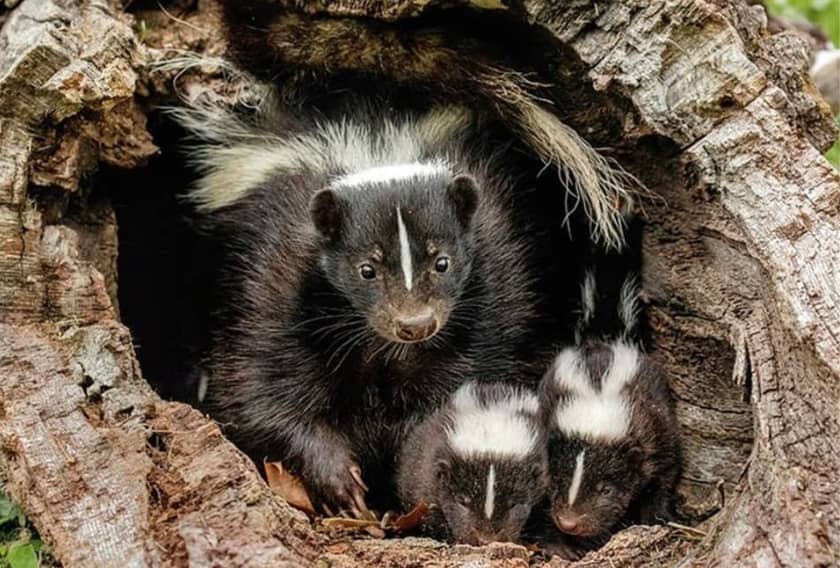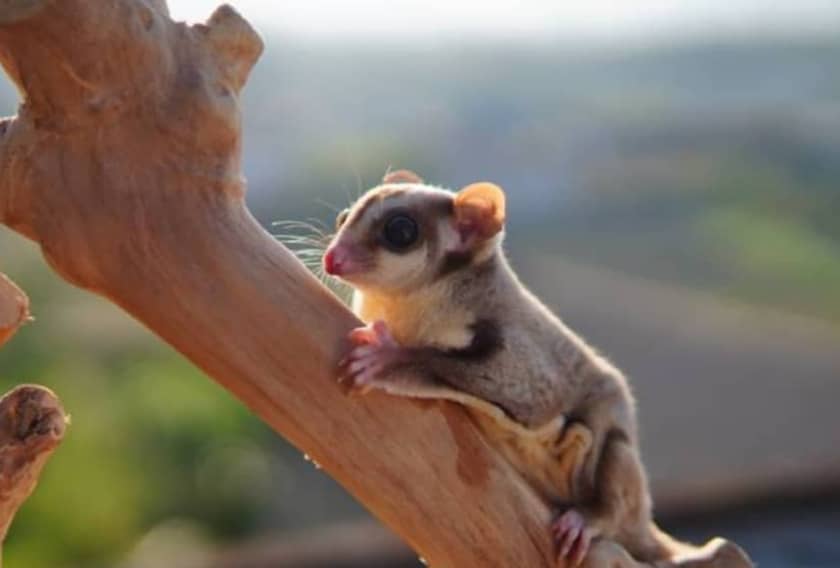The Northern Flying Squirrel is a small, nocturnal rodent found in North America. The northern flying squirrel lives in coniferous and mixed coniferous woods across North America, from Alaska to Nova Scotia, south to the mountains of North Carolina and Tennessee, and west to Utah.

These nocturnal, arboreal rodents have thick, light brown or cinnamon hair on top, greyish fur on the flanks, and white fur below. They have big eyes and a flat tail. Their ears are round, tiny, and lightly furred. They are skilled gliders but poor walkers on the ground. They have a hairy membrane termed a ‘Patagium’ that runs between their front and back legs.
Glaucomys sabrinus is the scientific name of the southern flying squirrel; from Greek, it means silver-gray (glaukos), and mouse (mys). They eat a variety of plant items, including tree sap, fungi, insects, carrion, bird eggs, and nestlings. They typically reproduce once per year in a cavity lined with lichen or other soft material.
Size Information
They can also be distinguished by their long whiskers, which are characteristic among nocturnal animals. The adult northern flying squirrel is 25 to 37 centimeters tall and weighs between 110 and 230 grams.
Life Expectancy of the Northern Flying Squirrel
In the wild, southern flying squirrels often live for 5-7 years. In captivity, where they are safe from predators and have a constant food source, they can survive for 10–12 years.
Male Vs. Female Flying Squirrels
Male and female flying squirrels have similar appearances. After the young are born, females reside with them in neighboring matarnal nest areas.
Mothers are very protective and nurturing. Males are not permitted near the maternal nests and are not involved in rearing the young.
Behavior and Temperament of the Northern Flying Squirrels
Flying squirrels nest in tree cavities and use lichen, dried grass, and finely shredded bark to line their nests. Sometimes an abandoned woodpecker nest will be used. They are amazing gliders and can move about the treetops, gliding up to 100 feet (up to 30 m).
Flying squirrels are communal. They usually share a home, with more males than females in a nest. They are mostly active in the dark, and they are the only species that are nocturnal and spend most of the time in trees because walking is so difficult for them with the “patagium” membrane between their wrists and ankles. Flying squirrels are very friendly and give quick responses when maintained properly.
Also, The northern flying squirrel has an intriguing characteristic that distinguishes it from many other mammals: they are florescent. When exposed to ultraviolet (UV) light, their fur glows pinkish, which is both unusual and exciting. This fluorescence is supposed to be a means to communicate with each other and camouflage with their predators in their nocturnal environment. This fluorescence can be seen mostly on their tails and bellies. Their glowing bellies work as beacons, allowing them to discover each other at night.
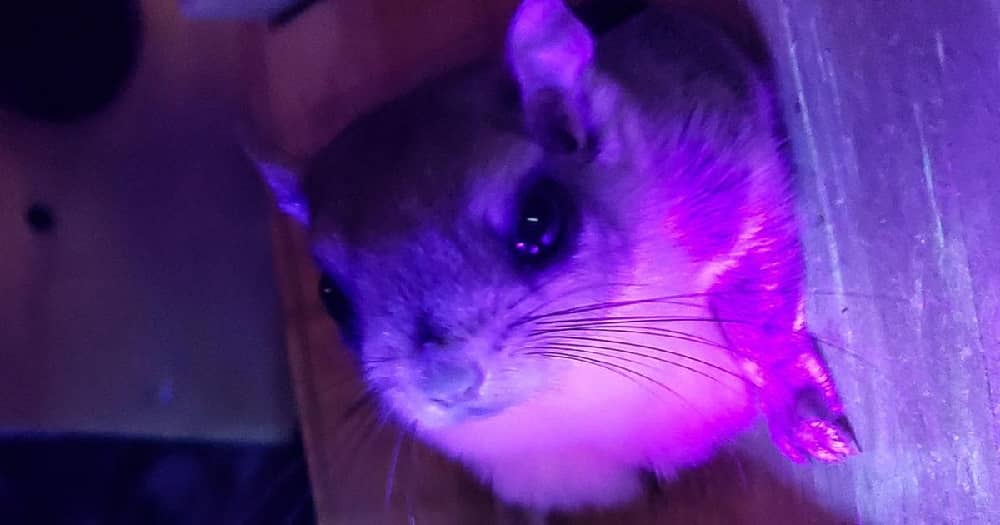
How to Care for The Northern Flying Squirrel?
A Northern Flying Squirrel needs attention to their specific needs, including diet, habitat, and social interaction.
Diet:
Flying squirrels consume berries, blooms, buds, cherries, and all sorts of nuts, except walnuts, whose shells are too hard to chew. They also consume meat, insects, or stolen bird eggs.
Treats can be given to your flying squirrels, like boiled eggs or chicken for extra protein in their diet. Foods having calcium and vitamins are also required of them, so you can give a calcium and vitamin supplement with their food. Limit phosphorous-rich items in your Northern flying squirrel’s diet since they can interfere with calcium absorption. Prepackaged, prepared foods for flying squirrels are available online, although the nutritional content varies.
The northern flying squirrel is also known to save food for times when food resources are limited. They save in tree cavities or in squirrel nests. Lichens and seeds are often stored.
Habitat
The enclosure should be escape-proof, with branches, ropes, and platforms to continue their natural climbing behavior.
To choose the perfect enclosure for your flying squirrel, you must ensure that bars have small spaces between them to prevent escapes or injuries, especially if you have a small, young flying squirrel.
Cages must have more vertical height than horizontal, as squirrels like to glide high and enjoy climbing. Metal cages should be used for them, as they would chew wooden ones and metal would be hard for them to chew through. Make sure to arrange some branches and ropes made of chemical-free cotton fibers in the cage onto which your flying squirrel can climb. Also, provide some nest boxes made of soft cotton fabrics where they can sleep comfortably.
Specific Substrate Needs
Arrange platforms and ladders to offer fun while encouraging climbing and exploring. Give your squirrel a big space to perform short glides. If your cage is large enough, you could do this within it.
Exercise
Flying squirrels are energetic and active but are nocturnal, so they are active at night. If you want to make sure that your squirrel stays healthy and fit, you should wake your squirrel in the morning and take it out of the cage to glide and climb into your house to maintain their health.
You can also offer some toys and wooden blocks to entertain your squirrel.
Include a solid-surface exercise wheel for running. Also, play with your squirrels; they are very friendly in nature, so it is easy for you to make close bonds with them.
How to Handle a Northern Flying Squirrel?
Let your squirrel establish trust in you first, then use hand-feeding. You must be patient, and when your squirrel gets comfortable, hold their body with both of your hands. Do not make unnecessary movements, which can shock them. Bring them close to your chest for safety, and always carry them during their active hours. To handle them properly, you must respect their natural behavior and avoid forcing engagement. With time, they would get familiar with your presence.
Health Issues With Northern Flying Squirrel
The northern flying squirrels do not require regular vaccines. Still, they are vulnerable to some health issues such as dental problems, obesity, dietary inadequacy, and so on.
Calcium shortages in your flying squirrels can cause metabolic bone disease (MBD), which results in weak bones and fractures. Flying squirrels have continually growing teeth. If they do not chew on enough hard objects, their teeth may expand, resulting in feeding issues and infections.
Northern flying squirrels are often resilient in captivity. In contrast, wild flying squirrels in the United States are infected with typhus, an infectious illness that can be spread to humans. This should not be an issue if you get a captive-bred squirrel from a reputable breeder and keep it away from wild squirrels. Find a veterinarian in your region who specializes in rodent treatment to safeguard your pet’s long-term health. Finding a strange pet veterinarian can be difficult, so contact local clinics and ask questions before buying a flying squirrel.
 Veterinary Treatment
Veterinary Treatment
Veterinarians frequently check the food to ensure it is nutritionally balanced. Northern flying squirrels, like other tiny animals, are susceptible to parasites like mites and fleas. To manage parasites, veterinarians may prescribe topical or oral drugs. If the squirrel has an injury, such as a fall or a bite wound, rapid veterinarian care is required. Signs of a deficiency, such as lethargy, weakness, or poor coat quality, necessitate rapid food changes and potentially vitamin or mineral supplementation. While there are no special vaccinations for northern flying squirrels, keeping a clean, stress-free habitat is essential. Preventative care also includes frequent monitoring for indicators of sickness and early treatment if any symptoms appear.
Grooming
There is no need to bathe or brush your flying squirrels. These creatures brush themselves with their tiny tongues and paws, so they keep exceedingly clean even without human help.
Ethics and Legality of Owning a Northern Flying Squirrel
Legality
The legality of keeping a northern flying squirrel varies greatly depending on your locality. In certain jurisdictions or nations, keeping them as pets is permissible, while in others, it is prohibited. Prior to purchasing a northern flying squirrel, it is critical to understand local legislation and secure any required licenses.
Violations of wildlife rules can result in significant penalties and legal repercussions. Always make sure that any pet you get is legally permitted in your region and comes from a reputable breeder that follows ethical standards.
Ethics
Ethically, keeping a northern flying squirrel as a pet necessitates a strong commitment to satisfying their unique requirements. Northern flying squirrels are quite gregarious and usually live in groups in the wild. Keeping a single squirrel can cause stress and behavioral concerns, so owners should evaluate whether they can provide essential companionship or whether they should adopt many squirrels.
Furthermore, northern flying squirrels can be harmed or killed by other pets (particularly cats), so avoid getting one if you have a troublesome pet at home.
Where to Buy?
The best way to get a southern flying squirrel is from a reputable breeder. Look for breeders that specialize in rare or small animals. They will also advise on the correct care and assist with any concerns that may develop.
Make sure you have a nearby exotic veterinarian who can treat your pet if an emergency occurs. The cost of a baby flying squirrel is around $900, but an adult can be owned for $300.
Upkeep Cost
The flying squirrel requires a suitable environment, healthy food, and veterinary care. Apart from an initial set cost of roughly $1000, you will be responsible for regular expenditures such as food, veterinarian care, and insurance. It might cost between $30 and $50 each month.
Reproduction and Breeding
The annual mating season starts in February and concludes in March. During this period, flying squirrels are monogamous; however, they may not pick the same companion year after year.
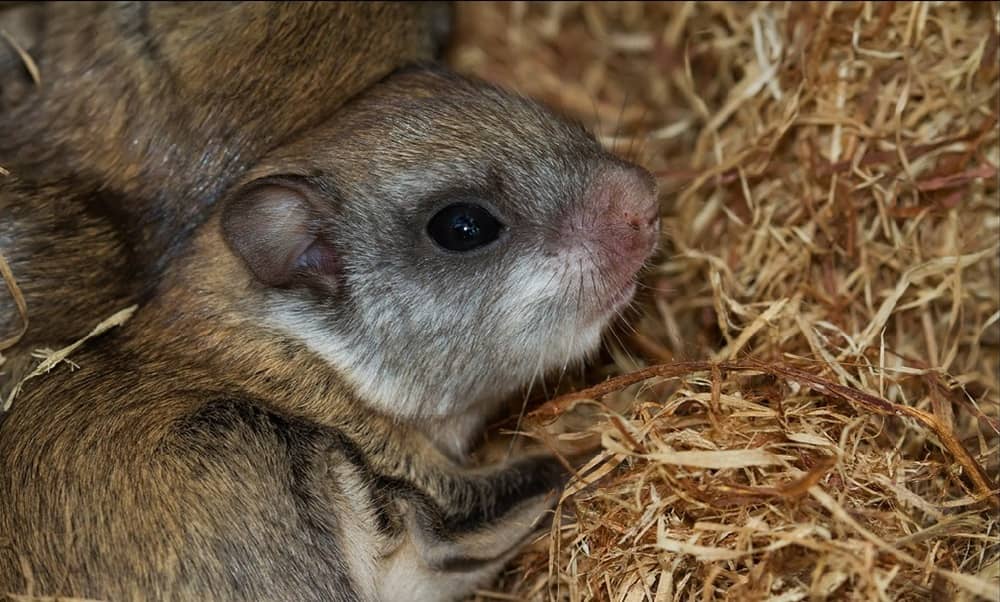
After forty days after mating, a litter of three to six pups is born. The thin, translucent skin membrane that will allow them to glide later in life is already present. The eyes and ears remain closed for the first 28 days. Nutrition is initially provided by the mother’s milk, followed by various sources such as insects and fragile twigs. Silky fur covers their nude body. At 8 weeks, the young have gained enough confidence to undertake their first glide. Near September, the squirrel will molt its coat in preparation for winter. After 18 months, the squirrel becomes an adult.
Related Species
The species related to The Northern Flying Squirrel are:
- The Southern Flying Squirrel (Glaucomys volans)
- Sugar Glider (Petaurus breviceps)
- Siberian Flying Squirrel (Pteromys volans)
- Japanese Dwarf Flying Squirrel (Pteromys momonga)
A Northern Flying Squirrel Vs. A Southern Flying Squirrel
Northern and Southern flying squirrels have similar appearances and features, yet they have some traits that make a difference between them. Some of the traits are there:
Physical Features:
Southern Flying squirrels have soft, gray-brown fur with a white belly and large, dark eyes adapted for their nocturnal lifestyle, whereas Northern flying squirrels fur is more reddish-brown with a cream-colored belly, and they also have large eyes, ideal for low-light conditions.
Size:
Southern Flying squirrels are smaller in size, about 8 to 10 inches long, including their tail, and weigh around 2 to 3 ounces, whereas Northern flying squirrels are slightly larger, ranging from 10 to 12 inches, and weigh between 4 to 6 ounces.
Diet and Foraging Behavior:
Southern Flying squirrels are omnivorous, preferring seeds, nuts, fruit, and insects. They are known to hoard food, particularly in the winter months, and frequently store it in tree cavities or underground, whereas Northern flying squirrels are also omnivorous but with a higher inclination towards fungi, lichen, and truffles. They play a vital role in forest ecosystems by spreading fungal spores, which help trees absorb nutrients.
Activity and Movement:
Southern Flying squirrels are florescent and extremely active at night, using their loose skin, or patagium, to glide from tree to tree. Their gliding distance can reach up to 150 feet, whereas Northern flying squirrels are also fluorescent and similar in nocturnal behavior but slightly less agile due to their size. They can glide impressive distances but often prefer shorter, safer jumps, especially in denser, colder forests.
Reproduction and Breeding:
Southern Flying squirrels breed twice yearly, in the spring and late summer. The female typically gives birth to 2-4 young after a gestation period of about 40 days, whereas Northern flying squirrels breed once a year, usually in late spring. The gestation period is similar, but they tend to have larger litters, with up to 6 young.
Sexual Maturity:
Southern Flying squirrels reach maturity at 1 year old, whereas Northern Flying squirrels also reach maturity at around 1 year.
Temperature Tolerance:
Southern Flying squirrels prefer warmer climates and are more commonly found in the Southeast United States. They are less tolerant of intense cold and frequently gather in groups to stay warm during the cooler months, whereas Northern flying squirrels are well-adapted to colder environments, thriving in the northern U.S. and Canada. Their thicker fur and habit of sharing nests with other squirrels enable them to survive hard winters.
A quick comparison: Northern Flying Squirrel Vs Southern Flying Squirrel
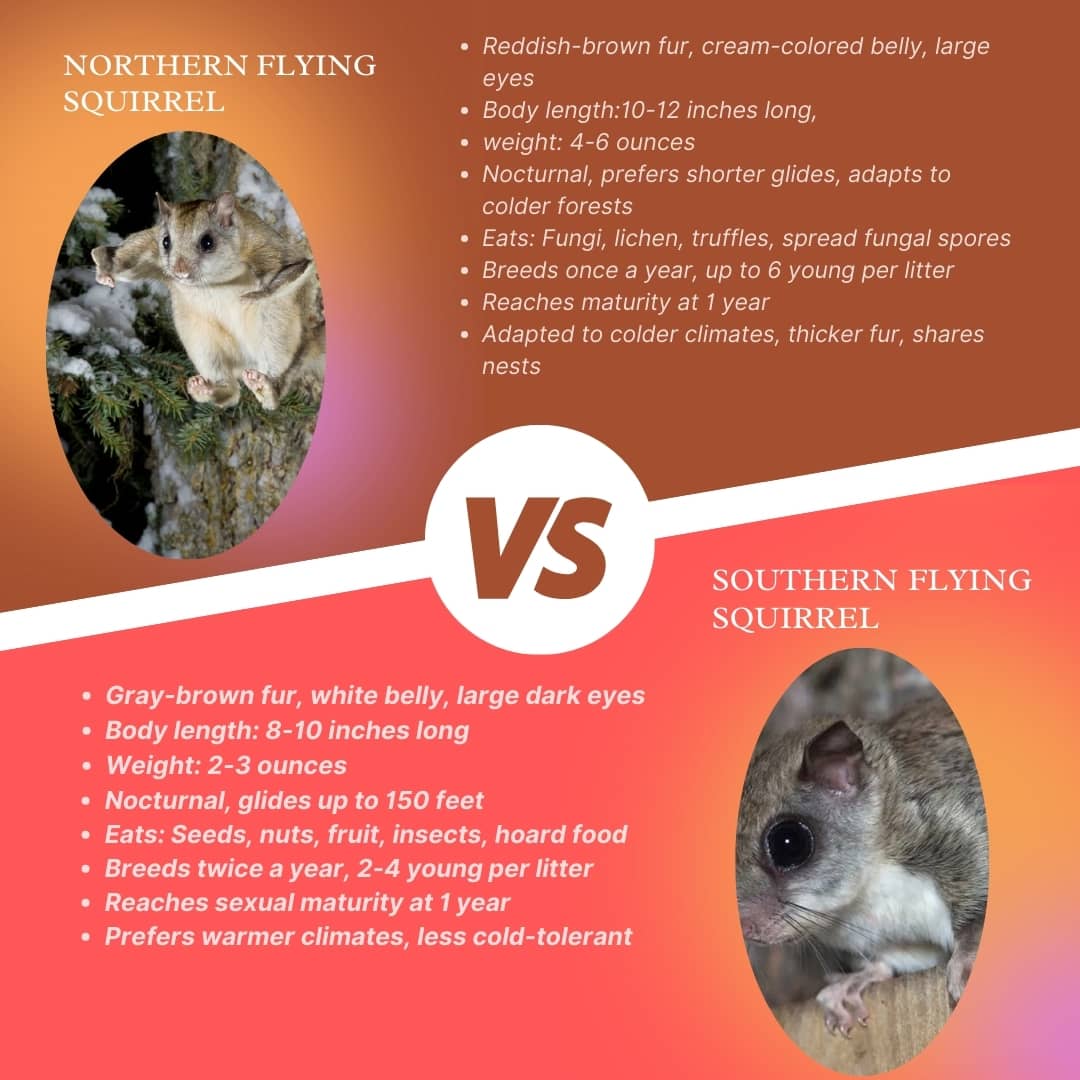
Interesting Facts About a Northern Flying Squirrel
- Unlike many squirrel species, northern flying squirrels are social creatures. They often share nests with other flying squirrels, especially in winter, to conserve warmth.
- Northern flying squirrels use a range of sounds to communicate, including ultrasonic calls that are beyond the range of human hearing.
- While they eat a variety of foods like nuts, seeds, and insects, northern flying squirrels have a special fondness for fungi.
- During winter, they lower their metabolic rate and huddle together in communal nests to conserve heat.
- Despite their widespread presence in North American forests, northern flying squirrels are rarely seen by humans.
- Northern flying squirrels are somewhat darker and redder than southern flying squirrels.
- The northern flying squirrel breeds once a year, but the southern flying squirrel breeds twice.

Frequently Asked Questions
Question 1-Can northern flying squirrels be kept with other pets?
Answer: Northern flying squirrels should be maintained as solitary pets or with other flying squirrels. Introducing them to other pets can be unpleasant and even hazardous for both the squirrel and the other animals.
Question 2-What are the main threats to northern flying squirrels?
Answer: Northern flying squirrels face the greatest threat from habitat loss caused by deforestation. Furthermore, climate change and predation by owls, hawks, and other predators pose serious threats to their numbers.
Question 3-What role do northern flying squirrels play in the ecosystem?
Answer: Northern flying squirrels play an important part in their ecosystems by spreading fungal spores and seeds, which helps maintain forest health.
Question 4-Do northern flying squirrels hibernate?
Answer: No, northern flying squirrels do not hibernate. Instead, they remain active throughout the winter, foraging at night and relying on stored food and communal nesting to stay warm.
Question 5-How is the northern flying squirrel different from the southern flying squirrel?
Answer: The northern flying squirrel is often bigger and lives in colder, more northern latitudes, whereas the southern flying squirrel is smaller and lives in milder parts of the eastern United States. They also have modest variations in fur color and nutritional preferences.
Question 6-How do northern flying squirrels find their way at night?
Answer: Northern flying squirrels have big eyes that are suited to low-light circumstances, allowing them to see well at night. They also use their strong senses of smell and hearing to travel and find food in the dark.
Question 7-Do Flying Squirrels fake death?
Answer: Flying squirrels are funny creatures that fake their deaths sometimes to gain attention from their owners.
Conclusion
The northern flying squirrel is a wonderful species that represents nature’s wonder and complexities. These little creatures, sometimes hidden in the shadows of the night, glide softly through the trees, playing an important part in the ecosystems in which they live. Northern flying squirrels, with their distinct adaptations and important ecological contributions, serve as a reminder of the delicate balance that keeps our woods alive.
As you continue to explore and understand these incredible animals, you will not only gain knowledge but also a deeper appreciation for the natural world and the importance of conservation efforts. Protecting their habitats means that the northern flying squirrel and the rich biodiversity they sustain will thrive in our woods for many years to come.

